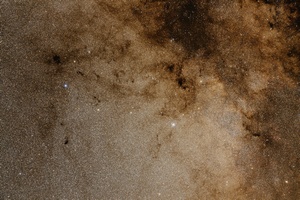Serpens & Scutum is the topic of Part #3 of our image presentation, where we want to share the results from our astrophotography-trip to ATHOS Centro Astronómico at La Palma.
Serpens ("the Serpent") is a constellation of the northern hemisphere and is one of the typical "summer constelletions". It is unique among the modern constellations in being split into two non-contiguous parts, Serpens Caput (Serpent Head) to the west and Serpens Cauda (Serpent Tail) to the east. Between these two halves lies the constellation of Ophiuchus, the "Serpent-Bearer".
A part of the Milky Way's galactic plane passes through Serpens Cauda, which therefore is rich in galactic deep-sky objects, such as the Eagle Nebula (IC 4703) and its associated star cluster Messier 16. The Eagle Nebula is a conspicuous region of active star formation, situated in Serpens Cauda. The starforming nebula, a giant cloud of interstellar gas and dust, has already created a considerable cluster of young stars. The cluster is also referred to as NGC 6611, the nebula as IC 4703.
vdB 123 is a small blue reflection nebula, embedded in the Serpens Molecular Cloud, which is part of the large local dark cloud complex called the Aquila Rift. To the west of vdB 123 one can find the Serpens Reflection Nebulosity (SRN), a very red bipolar reflection nebula.
IC 1276 (also known as Palomar 7) is a globular star cluster in constellation Serpens. Because of its position inside the Milky Way and its distance of 17,600 light-years the dust of the Milky Way reddens the colour of this globular cluster: E(B-V) = 0.92mag. The image quality of IC 1276 was also influenced by Calima (a hot, sand laden wind that blows in from the Northern Sahara) which worsened the transparency in both imaging nights.
Constellation Scutum is a small and not very bright cosntellation. Although not a large constellation, Scutum contains several open clusters, as well as a globular cluster and a planetary nebula. The two best known deep sky objects in Scutum are M11 (the Wild Duck Cluster) and the open cluster M26 (NGC 6694).
The most prominent open cluster in Scutum is the Wild Duck Cluster, M11. It was named by William Henry Smyth in 1844 for its resemblance in the eyepiece to a flock of ducks in flight. The cluster, 6200 light-years from Earth and 20 light-years in diameter, contains approximately 3000 stars, making it a particularly rich cluster. It is about 220 million years old.









